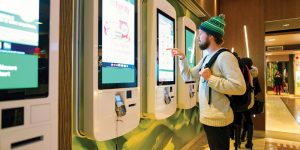— By Jeff Hill —
The growth of self-service kiosks presents new challenges for quick-service restaurant facilities teams.
Do you like self-service kiosks, or would you prefer to interact with a human cashier when visiting your favorite quick-service restaurant (QSR)? Your answer to that question, unsurprisingly, is likely driven by your age:
- 18- to 24-year-olds are more than 70% likely to visit a restaurant if it had a kiosk option;
- 25- to 34-year-olds are 65% more likely to visit;
- 45- to 54-year-olds are 60% more likely; and
- Over 55-year-olds are 40% more likely.1

Jeff Hill, Nuvolo
Initially developed as a mechanism to save labor costs or staff QSRs in tight labor markets, self-service kiosks have demonstrated an invaluable ability to drive revenue:
“The increase in consumer spending when ordering through self-service kiosks is 30%. Léa French Street Food in Illinois, for example, found that kiosks encouraged customers to customize their orders… orders through the kiosk had an average check size of $17.17, while orders at the counter had an average check size of $9.79.”2
Given the growing popularity of self-service kiosks — especially among younger demographics — as well as the mounting evidence that their use prompts consumers to spend more, QSRs will be investing more in kiosk technology in the coming years (the kiosk market is projected to grow at an annual rate of 7.2% through 2021).3
Great news for kiosk manufacturers and QSR revenue, but how about facilities teams? Maybe not so much. The pressure on them is likely to increase faster than kiosk-driven orders.
Historically, investments in technology to more efficiently maintain a company’s physical plant have been justified on the basis of cost savings exclusively. Air conditioning units break, and when they do, it costs x to repair them. If that x can be reduced, the cost of the technology to do so can be justified. Further, although it may be conceptually true, it’s difficult to make the case that a broken air conditioner reduces the productivity of the workforce, thereby potentially costing the organization a market or revenue opportunity. Such analyses make for interesting business school research projects, but rarely contribute to real-world purchase decisions.
Without question, a broken air conditioner or elevator will inconvenience a workforce and customers, but it’s difficult to draw a straight line from that equipment failure to lost revenue. But what about a self-serve checkout kiosk at a grocery store? A self-ordering monitor at a coffee shop? A do-it-yourself copy machine in an office supply store? As technology transforms the way we make purchases, the machines we use to do so, and their availability — or lack thereof — have a direct impact on not only customer satisfaction, but revenue.
Printers in large office supply stores can generate more than $1,000 a day in revenue. More importantly, printing services can generate nearly a third of a store’s margin. An unusable copy machine is thus vastly more impactful to the company’s bottom line than a leaky faucet in the bathroom. (The healthcare industry has been familiar with the lost revenue of non-functioning assets since the ‘80s — MRI machines, for example, generate between $500 and $1,500 per scan4 for their owners when they’re operational…zero when they’re not.) As mentioned above, in some retail environments, consumers spend 30% more when using self-ordering kiosks than when ordering traditionally.
And like any other corporate asset (HVAC handlers, boilers, light sensors, revolving doors, bathroom sinks), they’ll break, need to be maintained, upgraded and replaced. But for revenue-generating assets, doing so quickly will have a more direct impact on the company’s bottom line than replacing a broken door handle. Investments in technology solutions that can improve uptime/decrease downtime for a revenue-generating asset are not only justifiable, but compulsory.
 It’s admittedly cliché, but in the case of self-service kiosks, time really is money. Customers unable to place an order at an open kiosk have three options: (1) wait for an available kiosk, (2) seek a cashier, or (3) leave the store in frustration. Woody Hayes, the famously colorful Ohio State football coach and a fan of running the football, was famous for saying that three things can happen when you throw a forward pass…and two of them are bad. In the case of a broken or unavailable self-service kiosk, three things can happen, and in the case of two of them, the QSR loses revenue.
It’s admittedly cliché, but in the case of self-service kiosks, time really is money. Customers unable to place an order at an open kiosk have three options: (1) wait for an available kiosk, (2) seek a cashier, or (3) leave the store in frustration. Woody Hayes, the famously colorful Ohio State football coach and a fan of running the football, was famous for saying that three things can happen when you throw a forward pass…and two of them are bad. In the case of a broken or unavailable self-service kiosk, three things can happen, and in the case of two of them, the QSR loses revenue.
It goes without saying that speed is the key. How fast can the unavailable kiosk be reported to the vendor in charge of its repair or replacement? How quickly can the vendor process the work order, assign a technician, travel to the QSR and repair the kiosk? If the process for reporting, assigning and completing the repair is manual, the time to repair the device is longer, and the lost revenue is greater.
Moreover, like all other facilities assets, if the preventative maintenance plan for the kiosk is established, automated and executed successfully, unplanned downtime will be minimized. And as we all have more experience with Murphy’s Law than we’d care to recall, the kiosk is much more likely to break during dinner rush than just before close.
So as QSRs invest in advanced ordering technology, attention to the facilities management operation and the corresponding technology underpinning that critical team will also pay dividends, perhaps more than the kiosk investment, itself.
1 www.kioskmarketplace.com/articles/restaurant-kiosks-serve-up-multiple-demographics/
2 www.pymnts.com/news/retail/2018/self-service-kiosks-qsrs-consumer-spending/
3 Ibid.
— Jeff Hill is director of product marketing at Nuvolo, a leading facilities management software, built natively on the ServiceNow platform. Nuvolo’s modern vendor and facilities management software is deployed at several brand-name retailers, convenience store chains and QSRs. For more info, visit www.nuvolo.com.
